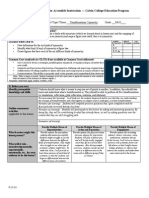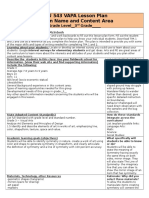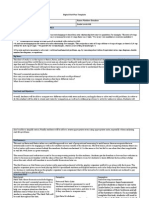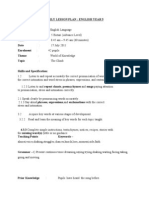Teamteachlp
Teamteachlp
Uploaded by
api-337781954Copyright:
Available Formats
Teamteachlp
Teamteachlp
Uploaded by
api-337781954Original Title
Copyright
Available Formats
Share this document
Did you find this document useful?
Is this content inappropriate?
Copyright:
Available Formats
Teamteachlp
Teamteachlp
Uploaded by
api-337781954Copyright:
Available Formats
Direct instruction
Teacher(s):Michael Salutz, Laura Curry, Morgan Matsen, Jose
Byrne
Subject: Congruent Triangles
Standard(s): Common Core, Arizona Career and College Ready Standards, ISTE Standards apply to this lesson
HS.G-C0.B.8: Explain how the criteria for triangle congruence (ASA, SAS, SSS) follow from the
definition of congruence in terms of rigid motions
Objectives (Explicit): Use Blooms verbiage and formula
Students will demonstrate application of rigid motion knowledge to triangle congruence by changing
triangles to determine if they are congruent.
Evidence of Mastery (Measurable): An actual product /Include an explanation of how you are going to grade/grading
tool? (rubric, checklist, etc.)
Summative: Students will fill out the quiz at the end of the class which asks about two specific triangles
and whether or not they are congruent (part of independent practice). During Guided Practice the students
will try out the applet and we will go around the class checking that they get the triangles correct. The
applet tells us specifically where the student it succeeding and where they may not understand.
Formative: Throughout the class we will be making Formative Assessments. I will ask the following
specific questions:
o Why are ASA triangles congruent and AAA triangles not?
o How are rigid motions and congruency related?
o How are congruency and similarity different? The same?
Sub-objectives, SWBAT (Sequenced from basic to complex): Content and Language objectives action verbs such as
write, list, highlight, etc.)
Recall rigid motion and how it applies to congruence.
Apply rigid motion congruence to triangles
Categorize the information necessary for triangles to be congruent
Key vocabulary:
Materials/Technology Resources to be Used:
Rigid motion
Congruence
Triangles
Reflection
Rotation
Translation
Laptop for every student
Congruence applet
Google Forms
Opening (state objectives, connect to previous learning, and make RELEVENT to real life) ENGAGE/ hook the students
Instructional Input
Get into small groups and put your ideas on the board. We give the basic rigid motions, they write
everything they know about this (draw picture, does it change the shape?, does it change the size? Is a
shape congruent to the shape created by the rigid motion)
Teacher Will: Be specific
Student Will: Be specific
Discuss what is meant by ASA and
AAA
Use applet to show examples of ASA
triangles, and show how they will
always be congruent. Discuss. (apply
Follow along with the work being
done in the applet
Participate in discussions about
congruences
Apply their knowledge of rigid
rigid motion congruence to triangles)
Use applet to show examples of AAA
triangles, and show how they are not
necessarily congruent. Discuss.
motion congruence to triangles
Co-Teaching Strategy/Differentiation How will your instruction look different for those students who need
differentiation or accommodations during your instructional input/teaching?
Guided Practice
Teacher Will: Be specific
Student Will: Be specific
Congruence theorem online activity. Room is split into 4
groups and does the remaining congruences and
incongruences (SAS, SSS, AAS)/(ASS)
Use the online applet to try out different
combinations to check to see if they form congruent
triangles. If not, explain what makes the triangles
incongruent, such as it makes the triangles similar
but not congruent, meaning it can change size, or
The last side has more than one possible length.
Co-Teaching Strategy/Differentiation/Check for Understandinghow are you going to know if EACH student is
ready to move onto independent practice? And how are you going to differentiate if they do not understand?
Independent Practice
Students who need a more hands-on experience may follow along and use the applet on
their own computer
Students may draw the triangles we create if they prefer or if they do not have a computer
Students may use pencil and paper to work on making the triangles
Encourage students to look at flips and rotations to see that congruent triangles dont
always look congruent at first
Teacher Will: Be specific
Student Will: Be specific
Make online, two-question, quiz: are
these triangles congruent, why?
One set of triangles will be
congruent, one set will not be
Apply knowledge of congruence
criterion to determine which sets of
triangles are congruent/noncongruent
Show which criterion apply to each
set of triangles in order to justify
their answers: By AAA criterion,
these triangles are not congruent
Co-Teaching Strategy/Differentiation How will your instruction look different for those students who need
differentiation or accommodations?
Physical forms of the quiz should be available for students who do not have a computer/online access
Closing/Student Reflection/Real-life connections: What connections will students make to their real lives? What essential
questions will they reflect on in their closure of the lesson?
Architects use similar triangles and other shapes to build and ensure that things are even and
balanced
You might also like
- BDA (Before, During After) Lesson Plan TemplateDocument3 pagesBDA (Before, During After) Lesson Plan Templateapi-404225281No ratings yet
- Lesson 5-Using Similar TrianglesDocument4 pagesLesson 5-Using Similar Trianglesapi-269787508No ratings yet
- Triangle CongruencyDocument65 pagesTriangle Congruencylmb96389No ratings yet
- Ubd Curriculum TemplateDocument6 pagesUbd Curriculum Templateapi-368277133No ratings yet
- Lesson Plan 3Document3 pagesLesson Plan 3api-338888247No ratings yet
- Triangle Congruence Day 1: Lesson OverviewDocument5 pagesTriangle Congruence Day 1: Lesson Overviewapi-341224874No ratings yet
- Hannah W Lessonplan 1Document6 pagesHannah W Lessonplan 1api-490428211No ratings yet
- 2 25laagDocument1 page2 25laagapi-283548263No ratings yet
- Lesson Plan 5Document3 pagesLesson Plan 5api-283599791No ratings yet
- 02 Instructional Software Lesson Idea Template 2017 4Document6 pages02 Instructional Software Lesson Idea Template 2017 4api-361246102No ratings yet
- Unit - Map For Curriculum For Secondary Teachers - Standard 4Document9 pagesUnit - Map For Curriculum For Secondary Teachers - Standard 4api-245089911No ratings yet
- Unit PlanDocument59 pagesUnit Planapi-249470194100% (1)
- Ashley Lawson Final Project StudentDocument2 pagesAshley Lawson Final Project Studentapi-315324639No ratings yet
- Title of Lesson Grade Level Lesson Sources/ References: Ccss - Math.Content.2.G.A.1Document4 pagesTitle of Lesson Grade Level Lesson Sources/ References: Ccss - Math.Content.2.G.A.1api-313993232No ratings yet
- EDU 543 VAPA Lesson Plan Lesson Name and Content Area: Grade Level - 3 GradeDocument6 pagesEDU 543 VAPA Lesson Plan Lesson Name and Content Area: Grade Level - 3 Gradeapi-346211383No ratings yet
- Congruence and Similarity Lesson PlanDocument3 pagesCongruence and Similarity Lesson Planbshashi9100% (1)
- Extended Lesson Plan 1-15-19Document7 pagesExtended Lesson Plan 1-15-19api-450378895No ratings yet
- m422 LessonDocument5 pagesm422 Lessonapi-376377139No ratings yet
- Lesson planDocument6 pagesLesson planqgvdbehqexcekrvhxpNo ratings yet
- 628 Flipped Classroom Lesson PlanDocument7 pages628 Flipped Classroom Lesson Planapi-252876251No ratings yet
- Lesson Plan AssignmentDocument3 pagesLesson Plan Assignmentapi-326628389No ratings yet
- Lesson Plan 3Document4 pagesLesson Plan 3api-283599791No ratings yet
- Right Triangle Lesson PlanDocument2 pagesRight Triangle Lesson Planapi-466088903No ratings yet
- 3D Shapes Lesson PlanDocument4 pages3D Shapes Lesson Planbronowiczb100% (1)
- Complete Unit OverviewDocument5 pagesComplete Unit Overviewapi-269787508100% (1)
- Math Lesson PortfolioDocument7 pagesMath Lesson Portfolioapi-310961869No ratings yet
- Lesson Planning Form For Accessible Instruction - Calvin College Education ProgramDocument4 pagesLesson Planning Form For Accessible Instruction - Calvin College Education Programapi-300871680No ratings yet
- Hon Option Math Lesson 5Document5 pagesHon Option Math Lesson 5api-315433454No ratings yet
- MYP Unit Planner: Stage 1: Integrate Significant Concept, Area of Interaction and Unit QuestionDocument6 pagesMYP Unit Planner: Stage 1: Integrate Significant Concept, Area of Interaction and Unit QuestionMohammad AliNo ratings yet
- Edu 506 Unit Plan OutlineDocument5 pagesEdu 506 Unit Plan Outlineapi-374782874No ratings yet
- Teaching Experiment Lesson Plan TemplateDocument4 pagesTeaching Experiment Lesson Plan Templateapi-282906321No ratings yet
- Triangle Inequality Theorem Lesson PlanDocument3 pagesTriangle Inequality Theorem Lesson PlanManilyn SuarezNo ratings yet
- Angles Are Just Plane' Easy: Grade ContinuityDocument9 pagesAngles Are Just Plane' Easy: Grade Continuityapi-252309040No ratings yet
- Edu 537 Lesson Plan Final Copy (Ass and Com)Document24 pagesEdu 537 Lesson Plan Final Copy (Ass and Com)api-284596984No ratings yet
- Boom Lessonstudyplan4 Dimaria BogoffkbDocument9 pagesBoom Lessonstudyplan4 Dimaria Bogoffkbapi-214017049No ratings yet
- Triangle Diagonal LessonDocument5 pagesTriangle Diagonal Lessonapi-213107438No ratings yet
- Pettway Ed508-5e-LessonDocument3 pagesPettway Ed508-5e-Lessonapi-693033816No ratings yet
- Reynoso Analysisspring JP 1Document5 pagesReynoso Analysisspring JP 1api-317494853No ratings yet
- Rubino During Reading LepDocument4 pagesRubino During Reading Lepapi-341209699No ratings yet
- Tag Compare Contrast Lesson Take 2Document17 pagesTag Compare Contrast Lesson Take 2api-269916717No ratings yet
- 3c. Prove Theorems About Parallelograms Lesson PlanDocument2 pages3c. Prove Theorems About Parallelograms Lesson PlanDhingcoi Czc Allado AducalNo ratings yet
- Gerst CS3lesson1Document2 pagesGerst CS3lesson1Lindsay GerstNo ratings yet
- Digital Unit Plan Template Unit Title: Triangles Name: Mackenzie Sheppard Content Area: Math - Geometry Grade Level: 9 & 10Document2 pagesDigital Unit Plan Template Unit Title: Triangles Name: Mackenzie Sheppard Content Area: Math - Geometry Grade Level: 9 & 10api-403395161No ratings yet
- Lesson Plan DEMODocument3 pagesLesson Plan DEMOSlrc IdoNo ratings yet
- Lesson 2 Perimeter and Area in The Coordinate PlaneDocument3 pagesLesson 2 Perimeter and Area in The Coordinate Planeapi-283338157No ratings yet
- Group 5 Udl Lesson PlanDocument4 pagesGroup 5 Udl Lesson Planapi-290106354No ratings yet
- Lesson Plan 2Document3 pagesLesson Plan 2api-338888247No ratings yet
- Illuminations Congruence TheoremsDocument2 pagesIlluminations Congruence Theoremsapi-219434647No ratings yet
- Lesson Plan - ParallelogramsDocument4 pagesLesson Plan - Parallelogramsapi-23666822950% (2)
- Transformations of Trigonometric FunctionsDocument4 pagesTransformations of Trigonometric Functionsapi-466088903No ratings yet
- Digital Unit Plan Template1Document4 pagesDigital Unit Plan Template1api-251328165No ratings yet
- Lesson Plan Template Fall 2013 MoneymattersDocument9 pagesLesson Plan Template Fall 2013 Moneymattersapi-237129156No ratings yet
- Completeunitplan 1Document8 pagesCompleteunitplan 1api-355201738No ratings yet
- Lesson Makeover Assignment: Andrea NanceDocument4 pagesLesson Makeover Assignment: Andrea Nanceapi-282373455No ratings yet
- Wingett Studentanalysis2Document7 pagesWingett Studentanalysis2api-317475882No ratings yet
- Geogebra-Ssa Exploration EvaluationDocument2 pagesGeogebra-Ssa Exploration Evaluationapi-219434647No ratings yet
- Observation 3 Lesson 10 31Document6 pagesObservation 3 Lesson 10 31api-382492645No ratings yet
- Maths SymmetryDocument4 pagesMaths Symmetryapi-360396514No ratings yet
- Unit Plan Overview: CurriculumDocument5 pagesUnit Plan Overview: Curriculumapi-300666676No ratings yet
- ST ND RDDocument5 pagesST ND RDapi-337781954No ratings yet
- SyllabusDocument2 pagesSyllabusapi-337781954No ratings yet
- IntrolettertoparentDocument1 pageIntrolettertoparentapi-337781954No ratings yet
- Salutz TechnologypresentationDocument2 pagesSalutz Technologypresentationapi-337781954No ratings yet
- IssueletterDocument1 pageIssueletterapi-337781954No ratings yet
- Salutz TechnologyportfolioDocument2 pagesSalutz Technologyportfolioapi-337781954No ratings yet
- Salutz TechnologyintegrationDocument2 pagesSalutz Technologyintegrationapi-337781954No ratings yet
- Artifact 1-The Hobbit LessonDocument6 pagesArtifact 1-The Hobbit Lessonapi-291430586No ratings yet
- Adhd PDFDocument13 pagesAdhd PDFreds_sparksNo ratings yet
- Kinder-Dll Week 1Document21 pagesKinder-Dll Week 1jadad100% (4)
- European Journal of Foreign Language Teaching: Esin Dündar, Ali MerçDocument33 pagesEuropean Journal of Foreign Language Teaching: Esin Dündar, Ali MerçIihya UlumnNo ratings yet
- DDLDocument3 pagesDDLDon QuijoteNo ratings yet
- Sample of English Lesson Plan 3Document30 pagesSample of English Lesson Plan 3ika_nikan100% (3)
- Dependent and Independent Variables ExplainedDocument16 pagesDependent and Independent Variables Explainedapi-251539218No ratings yet
- Z Fuller 16343229 102091 Drama2b 1h 2016 Assessment 2Document26 pagesZ Fuller 16343229 102091 Drama2b 1h 2016 Assessment 2api-305377750No ratings yet
- Educational PsychologyDocument3 pagesEducational PsychologyCelesta PushpaNo ratings yet
- Journal Reflection FinalDocument4 pagesJournal Reflection Finalapi-350123955No ratings yet
- Education DirectoryDocument42 pagesEducation DirectoryAnonymous ffje1rpaNo ratings yet
- Engineering Mathematics - IIIDocument7 pagesEngineering Mathematics - IIIsanju dmNo ratings yet
- Hand-In Hand, Building Community On Common Ground: by Pamela Harris LawtonDocument8 pagesHand-In Hand, Building Community On Common Ground: by Pamela Harris Lawtonwa wambuuiNo ratings yet
- A Study of Perseption CAD1Document7 pagesA Study of Perseption CAD1outerraceNo ratings yet
- Selective Reading Assessment E-PortfolioDocument4 pagesSelective Reading Assessment E-Portfolioapi-489899928No ratings yet
- IIE Placed GradDocument5 pagesIIE Placed GradGocha OkreshidzeNo ratings yet
- Tpe 3 Artifact DifferentiatingDocument14 pagesTpe 3 Artifact Differentiatingapi-410887864No ratings yet
- CV of Saeed 11032024Document2 pagesCV of Saeed 11032024muhammadabusaeedNo ratings yet
- Ss Unit-Lesson Plan 1Document3 pagesSs Unit-Lesson Plan 1api-241269773No ratings yet
- Integrating Technology Inside The ClassroomDocument13 pagesIntegrating Technology Inside The Classroommac_lucky7100% (1)
- Teaching Large ClassesDocument3 pagesTeaching Large ClassesValerijaNo ratings yet
- Resume EnglishDocument2 pagesResume Englishapi-351131269No ratings yet
- Provisionally Pre-Selected Candidates Selected and Will Be Called For Interview As and When Scheduled Subject To Submission of Document(s)Document13 pagesProvisionally Pre-Selected Candidates Selected and Will Be Called For Interview As and When Scheduled Subject To Submission of Document(s)sah108_pk796No ratings yet
- Sample MaterialDocument350 pagesSample MaterialJennifer L. Magboo-OestarNo ratings yet
- Phinma University of Iloilo PHINMA Education SyllabusDocument2 pagesPhinma University of Iloilo PHINMA Education SyllabusAw Ds QeNo ratings yet
- Daily Lesson Log: 1 Grading Examination 1 Grading ExaminationDocument3 pagesDaily Lesson Log: 1 Grading Examination 1 Grading ExaminationCaridad AvilaNo ratings yet
- Unit 4 - Shool Education SystemDocument8 pagesUnit 4 - Shool Education SystemHà DímNo ratings yet
- On Tap Tuan 6Document19 pagesOn Tap Tuan 6Thao NguyenNo ratings yet
- Resume Kristin PowellDocument4 pagesResume Kristin Powellapi-288242509No ratings yet
































































































